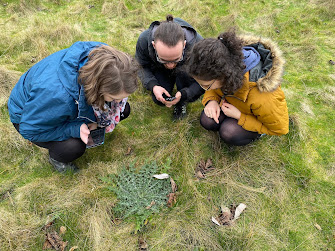Butterfly surveys ... in winter?
Confused? So was I when asked to help with December butterfly surveys. But, these weren't normal butterfly surveys. No, we were searching for butterfly eggs!
Although for most butterflies the most obvious way to search for them is in the spring and summer months as adults, for Brown Hairstreaks (Thecla betulae), egg searches are the most effective way to record this species and even to uncover a colony. The sites I surveyed have risen from 36 eggs to 186 eggs across only a year or two!
 |
| Winter hedge habitat for egg searches (Jen Jones) |
Butterfly lifecycles
There are a few habitat specialists which are surveyed in a different way to standard butterfly transects (example recording forms and methods are on the UKBMS webpage). These include the Brown and White-letter Hairstreak egg counts, but also Duke of Burgundy, and Large Blue egg counts and Marsh and Glanville Fritillary larval web counts. Interestingly, the Green Hairstreak is the only UK Hairstreak species to not overwinter as eggs.
 |
| WLH egg (Peter Eeles) |
 |
| WLH adult (Tim Melling) |
 |
| BH adult (Iain Leach) |
 |
| BH egg (Gillian Thompson) |
Methods - Brown Hairstreak eggs
Survey timing
Butterfly egg surveys take place in the winter as these species overwinter as eggs until April. Ideally eggs can be surveyed from October to mid-February. The earlier, the better as less eggs will be predated or damaged; try to aim for after Blackthorn leaves have been dropped.
Where to survey
As the BH is relatively rare and declining in populations, survey areas can be decided based on previous presence records and suitable habitat (such as hedges and scrubby Blackthorn suckers). OS maps and satellite images can be handy to look for where open access hedgerows, scrubby patches or woodland edge habitats (along roads, lanes, and adjacent to public footpaths). If needed, this letter can be used if you want to contact a landowner to agree access.
Habitat suitability can be easily assessed by a drive-by/walkover to look at the Blackthorn on site. Typically, a sunny aspect sheltered from the wind has a high chance of egg success. Management of hedgerows can provide more young growth and introducing scalloped edges to increase sheltered micro-climates for breeding, feeding and moving through typically exposed agricultural landscapes (Merckx and Berwaerts, 2010 and Hedgelink, 2013).
As long as the hedge has one of the six criteria present, it can be classed as potentially suitable. If a hedge fits all 6 criteria of ‘unsuitable’ habitat, then do not survey it. The list below are the suitable criteria for BH:
 |
| Zones for eggs from Devon Wildlife Trust |
 |
| Suitable Blackthorn hedges for BH eggs (Jen Jones) |
Eggs
Eggs are very small, about the size of a pinhead and are usually laid on Blackthorn suckers (20-200cm high, about knee to head height is a good rule-of-thumb) in the junctions of stems and branches. BH eggs look like mini white sea urchins, they are well-textured and they stand out easily against the darker stem colouration. A hand lens is very useful to bring along, as other species do lay their eggs on Blackthorn (see below).
 |
| Hairstreak eggs on Blackthorn (Upper Thames BC) |
 |
| Other eggs on Blackthorn (Upper Thames BC) |
 |
| Egg size (Jen Jones) |
 |
| 5 eggs (Bekah Beaumont) |
 |
| BH egg detail (Jen Jones) |
Winter tree ID
BH favour Blackthorn so some winter tree identification skill is needed. Hawthorn is one confusion species, it has lighter stems and longer and sharper thorns than Blackthorn, with red rather than black berries. Other Prunus species may lack thorns and flower at an earlier date than Blackthorn so this is another characteristic to look for.
Health and Safety
- Bring warm and waterproof clothing and make sure you have somewhere for regular breaks out of the cold (don't survey during snow, frosts, heavy rain, strong winds or fog as you will be very cold and not find eggs easily)
- Be careful when surveying along lane and road hedges, and leave them out if it is unsafe to use them (check for cars regularly).
- Hold branches firmly to avoid them springing back and whipping you in the face, and be careful of the thorns
Other useful information:
Monitoring hairstreaks
Three good in-depth training videos on BH egg searches from Herts & Middx Butterfly Conservation, Devon Wildlife Trust, and Surrey Butterfly Conservation.
Butterfly Conservation Upper Thames Branch Surveys - Single Species Surveys for Butterflies
Dave Wilton, 2009. Upper Thames Hairstreak Egg Surveys Report
Management for hairstreaks:
Butterfly Conservation and English Nature, 2004. Hedgerows for Hairstreaks leaflet.
Hedgelink, 2013. How to Manage your Hedges for Hairstreak Butterflies.




Comments
Post a Comment